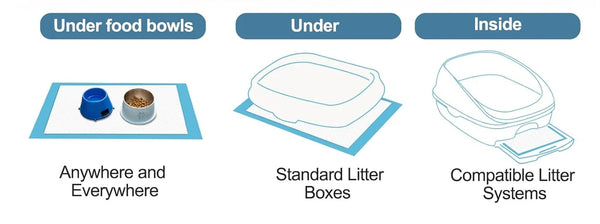Pee Pads: Not Just for Dogs Anymore - A Guide to Cats and Pee Pads
Pee pads have long been a staple in the toolkit of dog owners, serving as a convenient solution for indoor potty training and managing accidents. However, what many people may not realize is that pee pads can also be incredibly useful for cats. While cats are typically associated with their fastidious litter box habits, there are certain situations where pee pads can come in handy.

Why Would Cats Use Pee Pads?
Before delving into how cats use pee pads, it's essential to understand why they might need them in the first place. While cats are known for their litter box prowess, there are several scenarios where pee pads can be advantageous:
1. Medical Conditions: Cats, like humans and dogs, can experience medical issues that affect their bladder control. Urinary tract infections, kidney disease, and urinary incontinence are just a few examples of conditions that may make it difficult for a cat to reach the litter box in time.
2. Senior Cats: As cats age, they may develop mobility issues such as arthritis or muscle weakness, making it challenging for them to access a traditional litter box with high sides. Pee pads placed in easily accessible areas can provide a more comfortable alternative for senior cats.
3. Behavioral Problems: Cats are creatures of habit, but they can also experience stress or anxiety that leads to litter box aversion. Pee pads can serve as a temporary solution while you work to address the underlying causes of your cat's stress.
4. Travel: Whether you're taking a long road trip or just a quick visit to the vet, travel can be stressful for cats. Pee pads placed in carriers or travel crates provide a familiar substrate for elimination and can help minimize messes during transit.
5. Litter Box Training: Pee pads can also be helpful when litter box training kittens or transitioning cats to a new type of litter. They provide a soft, absorbent surface that cats may find more appealing than unfamiliar litter.
How Do Cats Use Pee Pads?
While the concept of using pee pads may seem straightforward, successfully introducing them to a cat's routine requires some patience and training. Here's how you can help your cat become accustomed to using pee pads:
1. Choose the Right Pee Pads: Start by selecting high-quality pee pads specifically designed for pets. Look for pads with a waterproof backing to prevent leaks and an absorbent core to contain moisture effectively.
2. Placement is Key: Identify areas in your home where accidents are most likely to occur or where your cat spends the most time. Place pee pads in these locations, making sure they're easily accessible to your cat. For senior cats or those with mobility issues, consider placing pads in multiple spots throughout the house.
3. Encourage and Reinforce: Initially, your cat may be hesitant to use the pee pads, especially if they're accustomed to using a litter box. Encourage them to use the pads by placing them in areas where your cat has previously had accidents. You can also try placing a small amount of their urine or feces on the pad to help them associate it with the appropriate elimination spot. Positive reinforcement, such as treats or praise, can also help motivate your cat to use the pads.
4. Be Patient and Consistent: Transitioning your cat to using pee pads may take some time, so be patient and consistent in your approach. Monitor your cat's behavior closely and be prepared to make adjustments as needed. Keep the pee pads clean and replace them regularly to maintain a clean and sanitary environment for your cat.

Tips for Successful Integration
Introducing pee pads into your cat's routine doesn't have to be a daunting task. Here are some additional tips to help ensure success:
1. Keep It Clean: Cats are notoriously clean animals and may be put off by dirty or soiled pee pads. Make sure to replace soiled pads promptly and clean the surrounding area with pet-safe cleaners to remove any lingering odors.
2. Provide Plenty of Options: If you have multiple cats or a large house, consider placing pee pads in several locations to give your cat plenty of options. This can help prevent accidents and ensure that your cat always has access to a suitable elimination spot.
3. Monitor Your Cat's Health: While pee pads can be a useful tool, they shouldn't replace regular veterinary care. Keep an eye on your cat's urinary habits and consult your veterinarian if you notice any changes or signs of discomfort.
4. Be Patient and Persistent: Like any training process, transitioning your cat to using pee pads may take time and persistence. Be patient with your cat and continue to provide positive reinforcement and encouragement throughout the process.
While pee pads have long been associated with dogs, they can also be a valuable tool for cat owners. Whether your cat is dealing with a medical issue, struggling with mobility issues, or simply needs a bit of extra help with litter box training, pee pads can provide a convenient and practical solution. By following the tips outlined in this guide and being patient and persistent, you can help your cat successfully integrate pee pads into their routine, ensuring a clean and comfortable environment for both you and your feline friend.